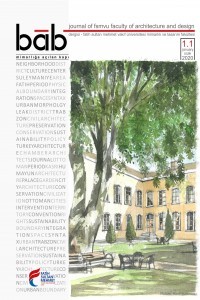Aşık Veysel İçin Mezar Tasarlamak: Kavramsal Düşünme ve Bir Stüdyo Pratiği
Mimarlık eğitiminde kavramsal düşünme, bilişsel yeteneği geliştirmesi açısından elzemdir. Kavramsal düşünme ve kavram, duyumsama, imgeleme ve algılama gibi öznel bilgi kaynakları aracılığıyla edinilir ve tasarımda akıl yürütme araçları olarak işlev görür. Böylece, tasarlama edimi, salt keşif amaçlı bir seyir olmaktan ziyade özne-nesne arasındaki bir etkileyiş kipinin sezgisel açılımı haline dönüşür. Bu çalışmanın kavramsal düşünmeyi sağlayan ve kavramlar üretmeye yardımcı olan temel araştırma nesnesi, Aşık Veysel’dir. Yöntem, ozanın ve yaşam dünyasının kavramsal ipuçlarının tasarlama edimine dahil edilmesinden oluşmaktadır. Sivas Cumhuriyet Üniversitesi Mimarlık Bölümü 2019-2020 eğitim yılında gerçekleştirilen bu çalışmanın başlıca değerleme kriteri, metinsel çözümleme ve kavram üretme becerisi gibi bilişsel etkinliklerden oluşmaktadır. Buna göre görsel imgeleme ve sözlü betimleme, tasarlama ediminin başlıca bilişsel aktivitesi olarak ortaya çıkmıştır. Sonuçta, kavramsal düşünme aracılığıyla aynı stüdyo grubundaki öğrenciler arasında farklı bilişsel yönelimler ve farklı öğrenme biçimleri olduğu saptanmıştır.
Anahtar Kelimeler:
Aşık Veysel, bilişsel yetenek, kavramsal düşünme, mezar, mimari stüdyo
Designing a Cenotaph for Aşık Veysel: Notional Thinking and a Studio Practice
Notional thinking in architectural education is crucial in terms of enhancing cognitive activity. Notional thinking and notion are obtained by subjective data sources such as sensation, imagination, and perception. These also function as reasoning tools in design. Thus, the design act transforms into an intuitive appreciation of an interaction mode rather than a cruise which aims to discover. Aşık Veysel is the fundamental research object of this study which enables notional thinking. The method consists of an involvement of notional clues in design on the basis of the folk poet and his life-world. The main assessment criteria of this study which is carried out at the department of architecture in Sivas Cumhuriyet University in the 2019-2020 academic year is comprised of cognitive activities such as analyzing texts and producing notions. Accordingly, visual imagination and verbal description are revealed as the chief cognitive activities of the design act. In conclusion, it is determined that different cognitive tendencies and different learning approaches are revealed by notional thinking between the students of the same studio.
Keywords:
Architectural studio, Aşık Veysel, cenotaph, cognitive ability, notional thinking,
___
- Kitap ANTONIADES, A. C., 1992. Poetics of architecture: theory of design. New York: John Wiley&Sons, Inc.
- ARNHEIM, R., 2009. Görsel düşünme. Çev: R. ÖĞDÜL, İstanbul: Metis Yayınları.
- KANT, I., 2015. Arın usun eleştirisi. Çev: A. YARDIMLI, 4. Baskı. İstanbul: İdea Yayınevi.
- KAYA, D., 2020. Aşık Veysel. 3. Baskı. Sivas: Sivas Belediyesi Yayını.
- LAWSON, B., 2005. How designers think the design process demystified. 4. Baskı. London and New York: Routledge Taylor &Francis Group.
- Kitapta bölüm ÇAĞLAR, N., 2019. Önsöz. İçinde: A. ÇELEN ÖZTÜRK, ed. Mimarlık okullarında tasarım stüdyoları: farklı denemeler. İstanbul: Yem Yayın. s. 6-11.
- ÖYMEN GÜR, Ş., 2017. Önsöz. İçinde: A. ÇELEN ÖZTÜRK, ed. Yunus Emre düşünce evi habitat atölyesi 2016-2017 güz dönemi mimari tasarım stüdyosu. Eskişehir: Osmangazi Üniversitesi Yayınları. s. i-viii.
- Dergide makale BASHIER, F., 2014. Reflections on architectural design education: The return of rationalism in the studio. Frontiers of Architectural Research. (3), s. 424-430.
- DÜZGÜN BEKDAŞ, H. ve YILDIZ, S., 2018. Tasarım ve sanat arakesitinde kavramsal düşünme: enformel eğitim çalışmaları (2009-2015). Megaron. 13 (2), s. 324-333.
- GOLDSCHMIDT, G., 1983. Doing design, making architecture. JAE. 37 (1), s. 8-13.
- GOLDSCHMIDT, G., 2017. Design thinking: A method or a gateway into design cognition?. The Journal of Design, Economics, and Innovation. 3 (2), s. 107-112.
- HASIRCI, D. ve ULTAV Z. T., 2012. An interdisciplinary approach to the design studio: poetry as a complementary feature to the creative process. Procedia-Social and Behavioral Sciences. (51), s. 618-634.
- HEYLIGHEN, A., CAVALLIN, H. ve BIANCHIN, M., 2009. Design in mind. Design Issues. 25 (1), s. 94-105.
- KOLKO, J., 2010. Abductive thinking and sensemaking: the drivers of design synthesis. Design Issues. 26 (1), s. 15-28.
- MUSTAN DÖNMEZ, B. ve KARABURUN, D., 2013. Türk halk müziği sözlerinde “metaforik anlatım geleneği”. Turkish Studies. 8 (4), s. 1081-1097.
- ŞENOCAK, E., 2017. Aşık Veysel’in şiirlerinde toprak ana. Turkish Studies. 12 (21), s. 503- 518.
- TOPAKKAYA, A., 2013. Aşık Veysel’in “güzelliğin on para etmez” adlı şiirine felsefi açıdan bir bakış. Türk Kültürü ve Hacı Bektaş Veli Araştırma Dergisi. (67), s. 89-102.
- TOPRAK, İ. ve HACIHASANOĞLU, O., 2019. Terms and concepts on design studio in the research articles of 2010’s. Journal of Design Studio. 1 (2), s. 13-22.
- TURHAN, M. ve KOVA, Ö., 2012. Değerler eğitimi açısından Türk halk müziği ve halk ozanları: Neşet Ertaş, Aşık Mahsuni Şerif, Aşık Veysel ve Özay Gönlüm bağlamında bir inceleme. Eğitim ve İnsani Bilimler Dergisi: Teori ve Uygulama. 3 (6), s. 117-128.
- İnternet kaynağı TRT ARŞİV, 1969. Aşık Veysel [çevrimiçi]. Erişim adresi: https://www.trtarsiv.com/program/asik-veysel/asik-veysel-118875 [Erişim Tarihi 5 Şubat 2021].
- Arşiv belgeleri SİVAS CUMHURİYET ÜNİVERSİTESİ, 2020. Mimarlık Bölümü MİM4002 Mimari Proje VIII eskiz sınavı sonuç ürünleri. [tasarım paftaları] Sivas Cumhuriyet Üniversitesi Arşivi, Sivas.
- Yayın Aralığı: Yılda 2 Sayı
- Başlangıç: 2020
- Yayıncı: Fatih Sultan Mehmet Vakıf Üniversitesi
Sayıdaki Diğer Makaleler
İslam Mimarlığının Kuramlaştırılma Meselesi: Turgut Cansever’in Yaklaşımı
Modüler Hücre Yapımın Çok Katlı Binalar Bağlamında İncelenmesi
Mehmet Selim ÖKTEN, Burcu BALABAN ÖKTEN, Savaş EKİNCİ
Aşık Veysel İçin Mezar Tasarlamak: Kavramsal Düşünme ve Bir Stüdyo Pratiği
Batılılaşma Ekseninde Mekteb-i Harbiye ve Mimari Dönüşümdeki Yeri
Modern Mimarlık Meselelerine Romantik Bakışlar: Turgut Cansever
Kütahya İlinin Kentleşme Süreci ve Geleneksel Konut Dokusunun Koruma Sorunları
